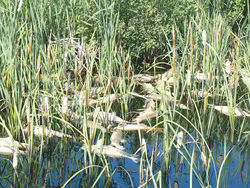
Normally the Fourth of July weekend at Short Creek Dam is a joyous and festive occassion. It wasn't this year.
When local Columbus Sportsmen's Club member Shannon Burau went to Short Creek last Friday morning to mow the campground in preparation for the big weekend, he discovered what he described as a sickening scene.
"It just made me ill. The whole shoreline was pretty much solid with dead fish and it was stinking like a lagoon," said Burau. "It was just a disaster, a disaster. I've never seen anything like it."
Short Creek Dam Recreation Area is located approximately seven miles north of Columbus. The reservoir covers 108 acres and entertains everything from fishermen to jet skiers. That wasn't the case over the Fourth.
"Nobody went swimming. Nobody," said Burau. "We had 30 to 40 campers out here, and tents, and everybody stayed on shore. The water was the color of tea on Friday and now (Wednesday) is like black, black coffee and getting darker every day."
A heavy downpour hit the Columbus area late last week, causing rapid and extensive runoff into Short Creek. The reservoir rose quickly and topped the spillway. While it is believed the deluge triggered the fish kill, the precise cause has yet to be determined. The Water Quality Division of the State Health Department first learned of the problem late Wednesday and made arrangements to dispatch officials to the scene.
Fred Ryckman, North Dakota Game & Fish Department fish biologist, visited Short Creek shortly after learning of the fish kill last Friday. Although unable to be reached for comment by The Minot Daily News on Wednesday, it was learned that Ryckman obtained water and fish samples from the reservoir.
"It was disgusting to see, but nobody can do anything about it. It's Mother Nature and the rain and too much water coming in too fast," said Wiley Post, a charter member of the Columbus Sportsmen's Club who was born and raised in the area. "The top water was too warm, 85 degrees. Too bad, too, the fishing was just picking up after about three years of being kind of slow."
An oily film could be seen floating on top of much of the reservoir Wednesday morning. Where the water had receded, shoreline vegetation was black in color. A sulfur-like smell was in the air. Water flowing over the spillway was dark brown in appearance and created a thick foam downstream, a situation not unusual when summer kills occur. Dying vegetation can quickly remove oxygen from water, particularly when still conditions persist during the overnight hours.
Short Creek has its origin near shallow Beaver Lake south of Lignite, flowing through agricultural land and areas of oil development. When leaving Short Creek Reservoir, the water flows north across the Canadian border and then into the Souris River and, eventually, back into North Dakota.
"We just don't know what gets washed in here," said Burau. "I don't want to point the finger at anybody. There's just no oxygen in the water."
According to Dennis Fewless of the Water Quality Division, tests will be conducted to determine the levels of nutrients, dissolved oxygen, dissolved solids and pesticides present in the water at Short Creek Dam. Some of the test results should be available in about one week. Other tests will take up to three weeks to complete.
"Usually you get a rain and it's wonderful. When you see perch swimming up onto the shore to get out of the water, you know something is wrong," said Burau.



What the heck is going on here?
"The water was the color of tea on Friday and now (Wednesday) is like black, black coffee and getting darker every day."
"An oily film could be seen floating on top of much of the reservoir Wednesday morning. Where the water had receded, shoreline vegetation was black in color. A sulfur-like smell was in the air. Water flowing over the spillway was dark brown in appearance..."
"Short Creek has its origin near shallow Beaver Lake south of Lignite, flowing through agricultural land and areas of oil development."